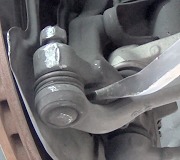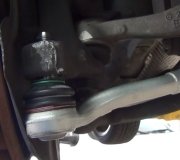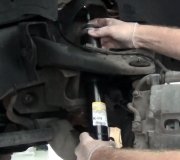The original upper is riveted in and can be rather frustrating to remove. At work we had a very large air chisel that made quick work of those rivets by shearing off the tops then punching them out. Regular air chisels will get the job done too but it will take longer and you'll want to wear ear protection. If I was to attempt one at home I would use an angle grinder to remove the heads, then I'd try a hammer and punch to pop the rivets out but understand they fatten out when they're pounded in and won't push out easily.
The replacements come with four bolts and nuts. If your old joint is a replacement already it will have those bolts instead of rivets. Bolts are easier to remove.
If the van was in perfect alignment before a ball joint developed sideways slop, you do not have to get it realigned when you replace the lower one because you're taking out a ball that was in the center of a housing that was in a round hole, so the new ball and stud will be exactly where it was before. That's not the case with the upper because it has that wing where the four bolts go through. No two upper ball joints are ever exactly the same, and there's a little wiggle room for you to move it around before you tighten the bolts. For that reason, even though you'll be putting the wheel back real close to where it was, the alignment should still be checked.
Without getting too complicated, many steering systems will cause the wheel / tire to turn left or right when something changes that makes it lean in or out. That provides a clue in the form of the steering wheel moving off-center when driving on a straight road. That doesn't happen on your van. If you look at the outer tie rod end from in front of the van, you'll see that it is exactly the same height off the ground as the lower ball joint. That means that when the upper ball joints lets the wheel tip in on top, the relationship between the steering arm on the spindle and the tie rod end doesn't change. That means no change in steering wheel position. I'm just mentioning that so you know that steering wheel position can't be used as a clue. However, depending on which way the upper ball joint is letting the wheel sit, there is going to be a pull one way when you let go of the steering wheel and it may be off-center to counteract that pull. Technically counteracting a pull is different that an off-center steering wheel. They're both off-center, but in one case you're tugging and holding it there and in the other it sits there by itself. I realize that's more than you care to know, but the bottom line is have it inspected and aligned when you're done.
Be sure to follow the torque specs for those four bolts too. It will be listed on the sheet that comes with the new ball joint. You can't rely on common sense either because those bolts will snap very easily from what feels right. If you do snap one you can use regular hardened bolts from the hardware store. They will withstand a higher torque.
Monday, August 27th, 2012 AT 8:25 PM



